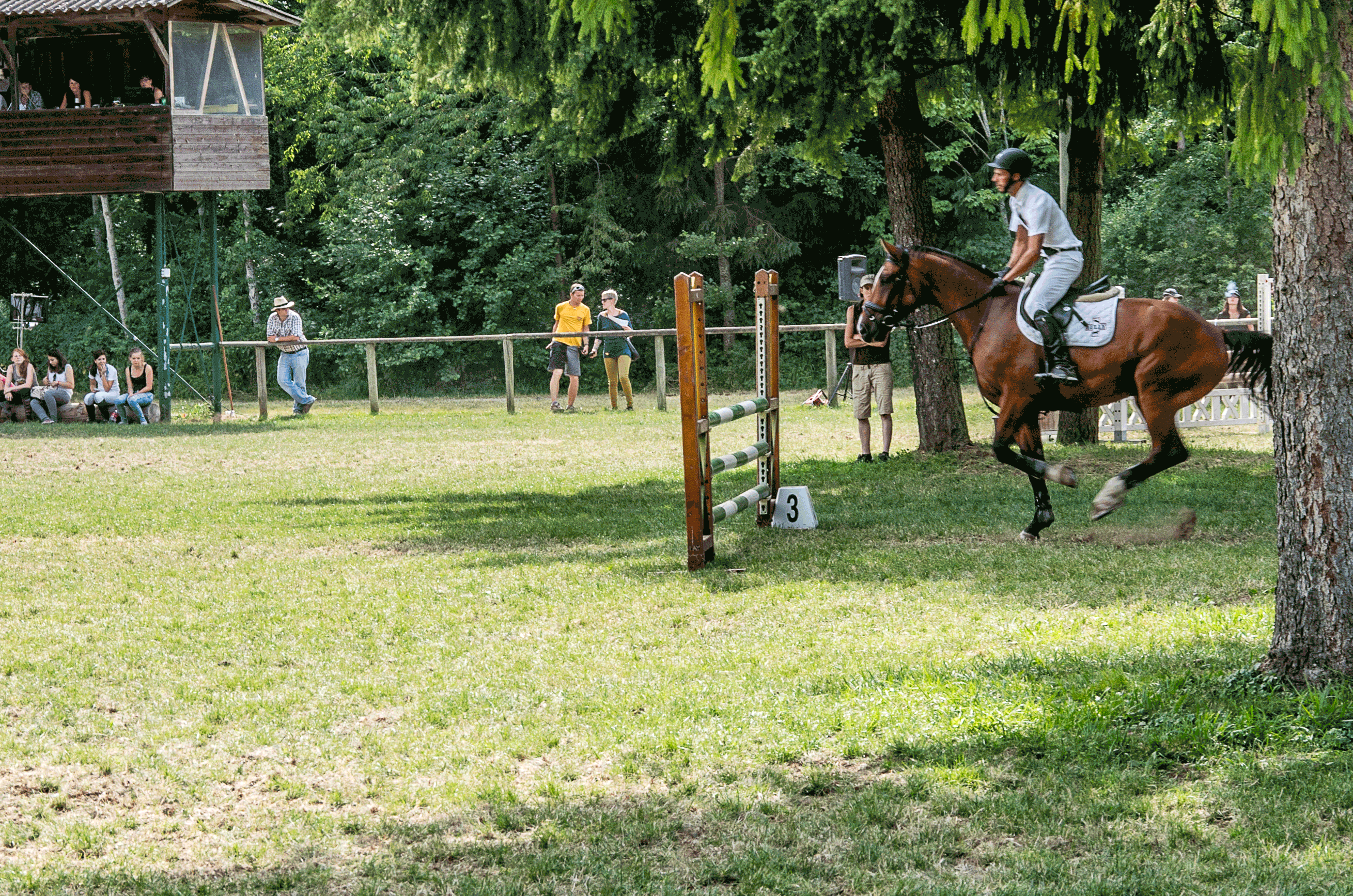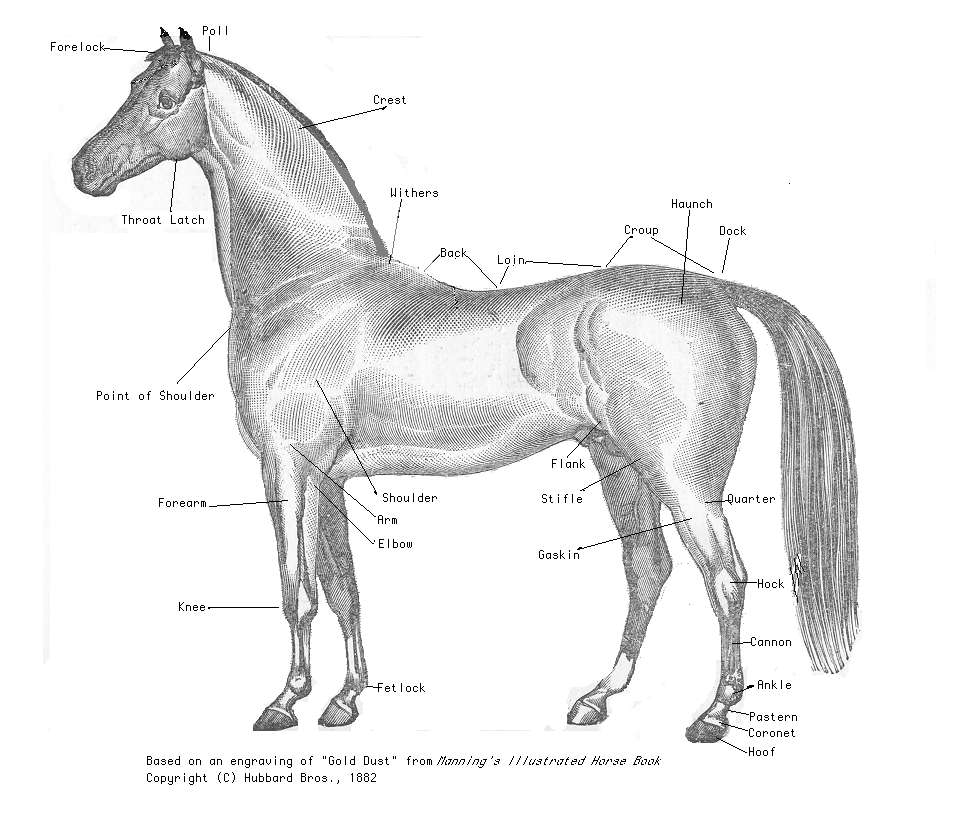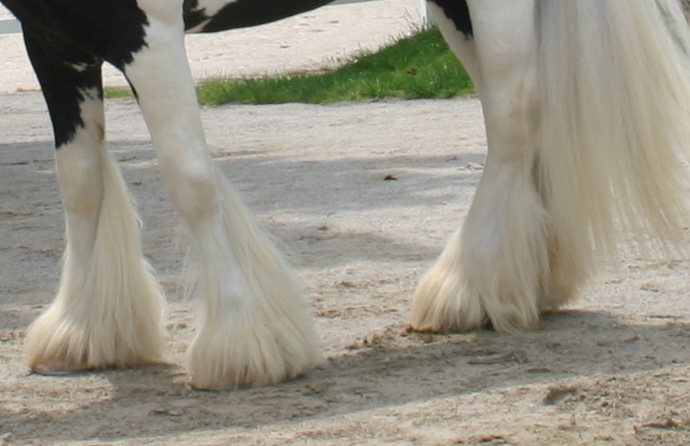|
Georgian Grande Horse
Georgian Grande Horse is a new horse breed being developed from crossbreeding the American Saddlebred with the Friesian horse and assorted draft horse breeds. The aim of the breeding is to create a Saddlebred-like horse that adds the best qualities of heavier breeds. One goal of the breed registry is to recreate a historic type of Saddlebred which was common prior to the 20th century, but that has been less emphasized in modern times. History The first attempts to create a new, heavier Saddlebred-type breed were made in the 1970s by George Wagner Jr, in Piketon, Ohio. His ambition was to recreate the stockier, sturdier look of the Saddlebred of older times, such as the animals used as cavalry mounts during the American Civil War. He considered this the original type of the Saddlebred horse instead of the prevailing modern, lighter type. Wagner's breeding succeeded in creating horses of the desired type, and the breed was named after him as "George's great horse". The breed ... [...More Info...] [...Related Items...] OR: [Wikipedia] [Google] [Baidu] |
Horse Breed
A horse breed is a selectively bred population of domesticated horses, often with pedigrees recorded in a breed registry. However, the term is sometimes used in a broader sense to define landrace animals of a common phenotype located within a limited geographic region, or even feral "breeds" that are naturally selected. Depending on definition, hundreds of "breeds" exist today, developed for many different uses. Horse breeds are loosely divided into three categories based on general temperament: spirited "hot bloods" with speed and endurance; "cold bloods," such as draft horses and some ponies, suitable for slow, heavy work; and "warmbloods," developed from crosses between hot bloods and cold bloods, often focusing on creating breeds for specific riding purposes, particularly in Europe. Horse breeds are groups of horses with distinctive characteristics that are transmitted consistently to their offspring, such as conformation, color, performance ability, or disposition. These ... [...More Info...] [...Related Items...] OR: [Wikipedia] [Google] [Baidu] |
Shire Horse
The Shire is a British breed of draught horse. It is usually black, bay, or grey. It is a tall breed, and Shires have at various times held world records both for the largest horse and for the tallest horse. The Shire has a great capacity for weight-pulling; it was used for farm work, to tow barges at a time when the canal system was the principal means of goods transport, and as a cart-horse for road transport. One traditional use was for pulling brewer's drays for delivery of beer, and some are still used in this way; others are used for forestry, for riding and for commercial promotion. The Shire breed was established in the mid-eighteenth century, although its origins are much older. A breed society was formed in 1876, and in 1878 the first stud-book was published. In the late nineteenth and early twentieth centuries, there were large numbers of Shires, and many were exported to the United States. With the progressive mechanisation of agriculture and of transport, the ... [...More Info...] [...Related Items...] OR: [Wikipedia] [Google] [Baidu] |
Hock (zoology)
The hock, or gambrel, is the joint between the tarsus (skeleton), tarsal bones and tibia of a digitigrade or Ungulate, unguligrade quadrupedal mammal, such as a horse, cat, or dog. This joint may include articulations between tarsal bones and the fibula in some species (such as cats), while in others the fibula has been greatly reduced and is only found as a Vestigiality, vestigial remnant fused to the distal portion of the tibia (as in horses).{{citation needed, date=January 2016 It is the anatomical Homology (biology), homologue of the ankle of the human foot. While homologous joints occur in other tetrapods, the term is generally restricted to mammals, particularly long-legged domestic animals, domesticated species. Horse Although the ''tarsus'' refers specifically to the bones and joints of the hock, most people working with horses refer to the ''hock'' in such a way to include the bones, joints, and soft tissue of the area. The hock is especially important in equine anatomy, ... [...More Info...] [...Related Items...] OR: [Wikipedia] [Google] [Baidu] |
Trot (horse Gait)
The trot is a ten-beat diagonal horse gait where the diagonal pairs of legs move forward at the same time with a moment of suspension between each beat. It has a wide variation in possible speeds, but averages about . A very slow trot is sometimes referred to as a jog. An extremely fast trot has no special name, but in harness racing, the trot of a Standardbred is faster than the gallop of the average non- racehorse, and has been clocked at over . On June 29, 2014, at Pocono Downs in Pennsylvania the Swedish standardbred Sebastian K trotted a mile in 1 minute, 49 seconds (quarters were passed at 26:2, 55:3 and 1,21:4). This is equivalent to a 1000-pace in 1.07,7 or 53.14 kilometers per hour or 33 miles per hour. From the standpoint of the balance of the horse, the trot is a very stable gait and does not require the horse to make major balancing motions with its head and neck.Harris, Susan E. ''Horse Gaits, Balance and Movement'' New York: Howell Book House 1993 pp. 35–37 Du ... [...More Info...] [...Related Items...] OR: [Wikipedia] [Google] [Baidu] |
Horse Hoof
A horse hoof is the lower extremity of each leg of a horse, the part that makes contact with the ground and carries the weight of the animal. It is both hard and flexible. It is a complex structure surrounding the distal phalanx of the 3rd digit (digit III of the basic pentadactyl limb of vertebrates, evolved into a single weight-bearing digit in horses) of each of the four limbs, which is covered by soft tissue and keratinised (cornified) matter. Anatomy The hoof is made up of two parts. The outer part, called the hoof capsule, is composed of various cornified specialized structures. The inner, living part of the hoof, is made up of soft tissues and bone. The cornified material of the hoof capsule differ in structure and properties. Dorsally, it covers, protects, and supports P3 (also known as the coffin bone, pedal bone, or PIII). Palmarly/plantarly, it covers and protects specialised soft tissues, such as tendons, ligaments, fibro-fatty and/or fibrocartilaginous tissues, an ... [...More Info...] [...Related Items...] OR: [Wikipedia] [Google] [Baidu] |
Jumping (horse)
Jumping plays a major role in many equestrian sports, such as show jumping, fox hunting, steeplechasing, and eventing. The biomechanics of jumping, the influence of the rider, and the heritability of jumping prowess have all been the focus of research. Jumping process The airborne phase of the jumping process occurs between stance phases of the fore and hind limbs and is therefore biomechanically equivalent to a highly suspended or elevated canter stride. For this reason, horses typically approach obstacles at the canter. The jumping process can be broken down into five phases: Approach The "approach" is the final canter stride before the jump, during which the horse places all four legs for the optimal take-off. The horse reaches forward and down with his neck to lower the forehand and his center of mass. The forelegs are propped or strutted out in front of the body. This relatively sudden braking action allows momentum to carry the hindlegs further under the body of th ... [...More Info...] [...Related Items...] OR: [Wikipedia] [Google] [Baidu] |
Equine Conformation
Equine conformation evaluates a horse's bone structure, musculature, and its body proportions in relation to each other. Undesirable conformation can limit the ability to perform a specific task. Although there are several faults with universal disadvantages, a horse's conformation is usually judged by what its intended use may be. Thus "form to function" is one of the first set of traits considered in judging conformation. A horse with poor form for a Grand Prix show jumper could have excellent conformation for a World Champion cutting horse, or to be a champion draft horse. Every horse has good and bad points of its conformation and many horses (including Olympic caliber horses) excel even with conformation faults. Conformation of the head and neck The standard of the ideal head varies dramatically from breed to breed based on a mixture of the role the horse is bred for and what breeders, owners and enthusiasts find appealing. Breed standards frequently cite large eyes, a br ... [...More Info...] [...Related Items...] OR: [Wikipedia] [Google] [Baidu] |
Rump (animal)
The rump or croup, in the external morphology of an animal, is the portion of the posterior dorsum – that is, posterior to the loins and anterior to the tail. Anatomically, the rump corresponds to the sacrum. The tailhead or dock is the beginning of the tail, where the tail joins the rump. It is known also as the base or root of the tail, and corresponds to the human sacrococcygeal symphysis. In some mammals the tail may be said to consist of the tailbone (meaning the bony column, muscles, and skin) and the skirt (meaning the long hairs growing from the tailbone). In birds, similarly, the tail consists of tailbone and tailfan (tail fan). Some animals are subjected to docking, the amputation of the tailbone at or near the dock. These include dogs, cats, sheep, pigs, and horses. Humans have a remnant tail, the coccyx, and the human equivalent of docking is coccygectomy. Usage Usage varies from animal to animal. Birds and cattle are said to have a rump and tailhead ... [...More Info...] [...Related Items...] OR: [Wikipedia] [Google] [Baidu] |
Back (horse)
The back describes the area of horse anatomy where the saddle goes, and in popular usage extends to include the loin or lumbar region behind the thoracic vertebrae that also is crucial to a horse's weight-carrying ability. These two sections of the vertebral column beginning at the withers, the start of the thoracic vertebrae, and extend to the last lumbar vertebra. Because horses are ridden by humans, the strength and structure of the horse's back is critical to the animal's usefulness. The thoracic vertebrae are the true "back" vertebral structures of the skeleton, providing the underlying support of the saddle, and the lumbar vertebrae of the loin provide the ''coupling'' that joins the back to the hindquarters. Integral to the back structure is the rib cage, which also provides support to the horse and rider. A complex design of bone, muscle, tendons and ligaments all work together to allow a horse to support the weight of a rider. Anatomy of the back The structure of the ... [...More Info...] [...Related Items...] OR: [Wikipedia] [Google] [Baidu] |
Horse Color
Horses exhibit a diverse array of coat colors and distinctive markings. A specialized vocabulary has evolved to describe them. While most horses remain the same color throughout life, a few, over the course of several years, will develop a different coat color from that with which they were born. Most white markings are present at birth, and the underlying skin color of a healthy horse does not change. Some Equine coat colors are also related to the breed of horse, like the Friesian breed for instance. The basic outline of equine coat color genetics has largely been resolved, and DNA tests to determine the likelihood that a horse will have offspring of a given color have been developed for some colors. Discussion, research, and even controversy continues about some of the details, particularly those surrounding spotting patterns, color sub-shades such as "sooty" or " flaxen", and markings. Basic coat colors The two basic pigment colors of horse hairs are pheomelanin ("red") ... [...More Info...] [...Related Items...] OR: [Wikipedia] [Google] [Baidu] |
Withers
The withers is the ridge between the shoulder blades of an animal, typically a quadruped. In many species, it is the tallest point of the body. In horses and dogs, it is the standard place to measure the animal's height. In contrast, cattle are often measured to the top of the hips. The term (pronounced ) derives from Old English ''wither'' (“against”), because it is the part of a draft animal that pushes against a load. Horses The withers in horses are formed by the dorsal spinal processes of roughly the 3rd through 11th thoracic vertebrae, which are unusually long in this area. Most horses have 18 thoracic vertebrae. The processes at the withers can be more than long. Since they do not move relative to the ground as the horse's head does, the withers are used as the measuring point for the height of a horse. Horses are sometimes measured in hands – one hand is . Horse heights are extremely variable, from small pony breeds to large draft breeds. The height at the ... [...More Info...] [...Related Items...] OR: [Wikipedia] [Google] [Baidu] |
Gypsy Vanner Horse
The Gypsy Cob, also known as the Traditional Gypsy Cob, Irish Cob, Gypsy Horse, Gypsy Vanner, or Tinker Horse is a type or breed of domestic horse from the islands Great Britain and Ireland. It is a small, solidly-built horse of cob conformation and is often, but not always, piebald or skewbald; it is particularly associated with Irish Travellers and English Romanichal Travellers of Ireland and Great Britain. There was no stud-book or breed registry for horses of this type until 1996, but as breeders developed standards and recorded pedigrees, there are now organizations that register qualifying horses.. From about 1850, travelling people in the British Isles began to use a distinct type of horse to pull their vardos, the caravans in which they had just begun to live and travel. The color and look of the breed were refined in the years after the Second World War. Horses of this type were first exported to the United States in 1996. Characteristics The Gypsy horse is u ... [...More Info...] [...Related Items...] OR: [Wikipedia] [Google] [Baidu] |








